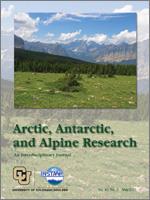Arctic regions hold considerable reservoirs of soil organic carbon. However, most of this carbon is in a potential labile state, and expected changes in temperature and water availability could strongly affect the carbon balance of tundra ecosystems. Plant community composition and soil carbon are closely tied to microtopography and position relative to the water table. We evaluated CO2 fluxes and moss contribution to ecosystem photosynthesis in response to fine-scale topography across a drained lake bed in Barrow, Alaska, during two contrasting growing seasons. CO2 exchange was assessed through static chamber measurements in three vegetation classes distinguished by plant dominance and topographic position within low-centered polygons. Gross primary production (GPP) and ecosystem respiration (ER) were the lowest under high soil moisture conditions in 2006. ER responded more strongly to wet conditions, resulting in a larger summer sink in 2006 than in 2005 (64 vs. 17g CO2 m−2, respectively). Microsites responded differently to contrasting weather conditions. Low elevation microsites presented a strong reduction in ER as a result of increased water availability. A maximum of 48% of daytime GPP and 33% of seasonal daytime GPP was contributed by moss on average across microtopographic positions. The interaction between fine-scale microtopography and variation in temperature and water availability can result in considerable differences in CO2 sink activity of the polygonal tundra.
How to translate text using browser tools
1 May 2011
Effects of Fine-Scale Topography on CO2 Flux Components of Alaskan Coastal Plain Tundra: Response to Contrasting Growing Seasons
Paulo C. Olivas,
Steven F. Oberbauer,
Craig Tweedie,
Walter C. Oechel,
David Lin,
Andrea Kuchy





